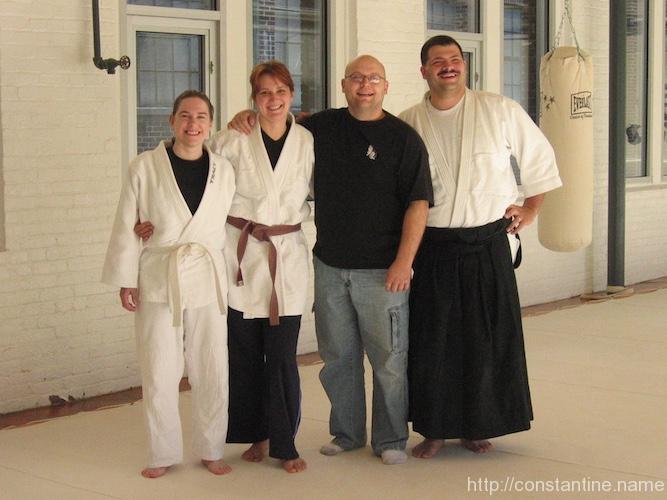Having dinner with some of the Aikido guys before a seminar tomorrow. Multiple black belt tests tomorrow.
ɕ

Having dinner with some of the Aikido guys before a seminar tomorrow. Multiple black belt tests tomorrow.
ɕ

ɕ
In college, I briefly practiced Taekwondo, and I spent 5 years practicing, and informally teaching, modern fencing. (Epée!) But I didn’t begin martial arts training in earnest until 1998, at age 26, when I began practicing Aikido under the direction of Sensei Michael Wirth. I practiced non-stop, reaching shodan (1st-degree black belt) in 2003 and godan (5th-degree) in 2013.
Sensei Wirth’s Aikido is an unaffiliated, no-nonsense, art; It is built on the bedrock principles of a soft and flowing Aikido, while honestly seeking to be physically functional and practical. On the mat, his Aikido is soft and flowing; It can vary very quickly from a light touch to vigorous atemi. In more recent years, I’ve repeated catch-phrases such as “No this. No that. No delay.” and “Relax beyond any indication of every injury you’ve ever received.” to convey the idea that you can be your most powerful only when you relax and eliminate all the unnecessary thinking and movements.
In the beginning, I had no clue how unique the Aikido group was that I’d stumbled into. It wasn’t until ten years or so into my journey that I realized the incredible luck of my timing: I started training just young enough to survive the tail-end of what I call Sensei Wirth’s “Does this work?” epoch, and was just old enough to thoroughly appreciate the subsequent, “Yes, it works. What can we do with it?” epoch. Those who experienced the former epoch nod knowingly with a serious expression. Those who experience the later epoch have the luxury of following the now more direct path that Sensei Wirth has arrived upon. The later epoch is certainly better, but the few of us who experienced both are indeed, very lucky.
Along the way, as I’ve wandered (physically and mentally), I’ve taken the opportunities to experience a wide range of Aikido styles, groups and teachers. I’ve gone to fundamentally different Aikido groups’ seminars just to honestly try the “when in Rome…” thing. I also made an honest effort of a couple years in Tai Chi. I expanded my practice by reading from a wide range of topics directly, and indirectly, related to Aikido including philosophy, physiology and spirituality. In fact, I would go so far as to say that I did my best to deconstruct and reassemble everything I’ve learned.
On the other hand, I make no claim to the quality of my reassembled puzzle since some pieces are missing, several are chewed on, and many which don’t fit remain to the side. All things considered? I’m delighted to still feel I am a beginner.
ɕ
Relaxation alone—even a specialized form of it—is not aikidō, however. If this internal power is a foundational skill—one largely abandoned today—the techniques of aikidō are its delivery system. Even with remarkable power, without a delivery system, one is no more able to fight than a power lifter is able to win in a boxing ring, just because he can bench press six hundred pounds.
~ Ellis Amdur from, http://www.guillaumeerard.com/aikido/articles/it-aint-necessarily-so-rendez-vous-with-adventure
Aikidoka: We talk a lot about Tohei Sensei, but how much time have you spent actually reading about him?
ɕ
Since 1998 I have been continuously and vigorously studying and practicing a martial art called Aikido. Over the years my responsibilities have gradually increased to the point where I am now straight-up teaching Aikido. I was having a terrific time exploring Aikido while trailing in the footsteps of many senior people. I’m now surprised to find that a bunch of people have appeared behind me asking questions.
What is this I don’t even…
I am currently teaching at the Kinokawa Aikido LV dojo, and I study under Sensei Michael Wirth at Main Line Budo.
ɕ